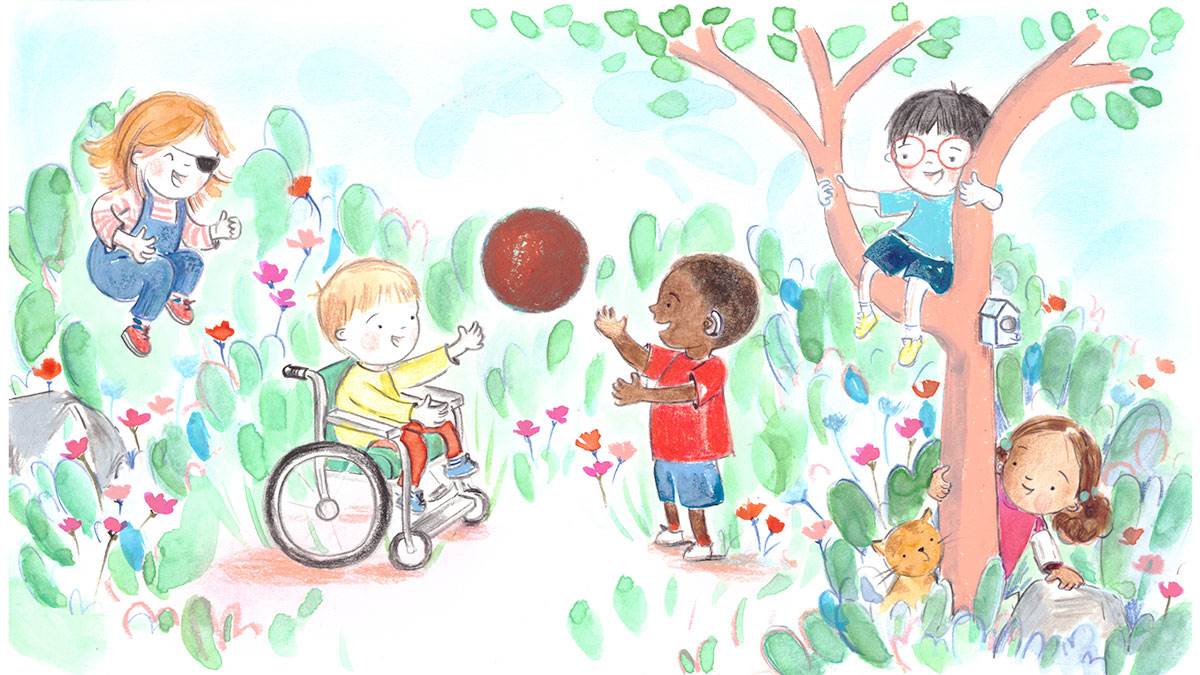Disabled characters and the need for authenticity
Published on: 5 Rhagfyr 2014 Author: Alex Strick
BookTrust consultant Alexandra Strick talks about the value of research and the need for more disabled children's writers and illustrators.
 This week saw the International Day of Disabled People. So what better day to celebrate the work of disabled children's book writers and illustrators? The only problem - where are all the disabled writers and illustrators?
This week saw the International Day of Disabled People. So what better day to celebrate the work of disabled children's book writers and illustrators? The only problem - where are all the disabled writers and illustrators?
Sadly, where the mainstream children's book world is concerned, there are remarkably few in print.
Of course, that's not say that one has to be disabled oneself in order to include a disabled character in a book. With a bit of thought and research, any illustrator should be able to include a disabled character somewhere in their books without vast amounts of first-hand knowledge. I am also not suggesting that disabled people should write only about disability.
However, there is most certainly a place for more in-depth depictions of disabled people in books - and if you are going to make your protagonist disabled, direct experience is going to be of great value, if not essential.
At very least, extremely thorough research is needed if the portrayal is going to be accurate, convincing and insightful.
Take Marcus Sedgwick's She is Not Invisible as a case in point. The successful creation of a credible blind protagonist was no doubt down to the substantial homework he did on the subject. Listening to young visually impaired people at an awards ceremony initially inspired him. This led him to contact specialist college (New College Worcester) where he sat in on classes and conducted one-to-one interviews. Having read up a lot on the subject, he then made the decision to concentrate on a particular form of visual impairment (blindness from birth) and learnt all he could about that specific condition. Only then did he start work on Laureth, and crucially he focused not on what she might be like in terms of being blind, but on her specific personality and how she - as an individual - might tackle the various challenges that faced her. The result is that what really strikes the reader is her bubbly personality, her quirks, her resourcefulness and her teenage insecurities.
The book succeeds in being an adventure about a girl who happens to be blind - rather than a book about blindness - whist still sharing plenty of interesting facts about what it can be like to be visually impaired along the way. For example, particularly effective is the way Laureth describes how she feels she must ensure people don't feel awkward uncomfortable about her impairment, by concentrating on 'looking' in their direction when she speaks.
Other writers have even more direct experience of the subject at hand. The award-winning Maggot Moon by Sally Gardner features a dyslexic protagonist - but it's not about dyslexia. It's the harrowing story of boy who is forced to stand up to a despotic regime. Yet it has much to say on the subject of dyslexia, and it does so in a decidedly original way.
The book sees its hero bullied by his classmates, written off by teachers and abhorred by a society which rejects difference.
However, as well as powerfully illustrating the negative attitudes that a person with dyslexia can encounter, the book also illustrates the remarkable potency of being able to 'see the world differently'. And Sally Gardner is herself severely dyslexic - even once being branded 'unteachable'. Poignantly, Maggot Moon is dedicated to all those who did not shine at school but 'who will own tomorrow.'
Interestingly, Gardner did not set out to make her hero dyslexic - it was only once the book was written that it became apparent from his perspective on the world that he was. However Gardner feels very strongly that children need to see other people with dyslexia both in books and in life.
Then there are picture books like Moonbird (by Joyce Dunbar, iillustrated by Jane Ray) and Freddie and the Fairy (by Julia Donaldson, illustrated by Karen George) each of which successfully offer a powerful message about deafness, whilst not allowing itself to be sidelined off into the realms of 'issue' books. Both books are backed up by a strong sense that the team behind the book boast a real knowledge of the subject.
To summarise, as regularly noted in this blog, the children's book landscape still needs many more books which feature disabled characters, but particularly more written by people with direct personal experience.
In signing off, I urge readers to look out for books by the likes of Lois Keith (titles such as A Different Life) and Jane Stemp (Secret Songs and Waterbound) whose superb writing style blended with a powerful and insightful depiction of disability illustrate exactly why we need more disabled writers in children's book publishing.
Topics: Bookmark, Disability, Features






Add a comment